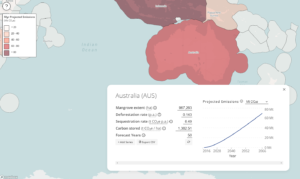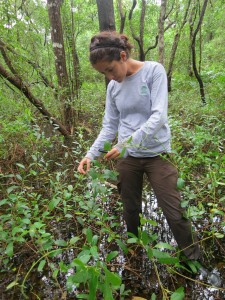The economic value of mangroves is being highlighted with new researchand anappthat projects carbon emissionsglobally.
In a first, the researchers compiledglobal data sets to projectbaselineglobal carbon emissions from different drivers of mangrove loss.

The team, led by Griffith University, focused on the five key drivers of carbon emissions from mangrove loss: clearing of the coast;urbanisation; aquaculture and agriculture; erosion; and extreme climatic events.
The results indicatedthe regions in need of policy actions to address emissions arising from mangrove loss and the drivers that could be managed to prevent them.
The Mangrove Carbon appallows users to explore the contribution of mangrove protection to mitigating carbon emissions.
Dr Chris Brown and Dr Fernanda Adame from Griffith’s Australian Rivers Institute and the Global Wetlands Project said the environmental and economic benefits of mangrove forests around the world should no longer go unnoticed.
“Mangroves accumulate three to 10 times more carbon than most ecosystems on the planet,” Dr Brown said.

Dr Fernanda Adame.
“Our projections help nations value mangrove conservation, identify what actions are needed to reduce emissions and set targets for reducing greenhouse gas emissions.
“For example, if mangroves are beingclearedfor aquaculturecreating1 million tons of CO2 every year, thiswould be the baseline amount of carbon emissions.If we manage aquaculture so that instead of deforesting new mangroves we fixedabandoned aquaculture ponds, wewouldavoid the emission of 10 million tons in the next 10 years.
“This project allows nations to value mangroves, predict potential carbon emission from mangrove loss and place a value on these to help meet targets set under the Paris Climate Agreement.”
The research, published inGlobal Change Biology, highlighted that Australia was doing relatively well compared with other regions of the world, but extreme climate events were a major cause of emissions.

Dr Chris Brown.
Overseas, emissions from mangrove loss were concentrated in five regions of the world,southeast and south Asia due to agriculture and aquaculture, and the Caribbean, west Myanmar and North Brazil due to erosion and clearing.
“We compiled the latest global data sets, and we not only estimated how much carbon there is in these places but how much carbon we would lose if we continued to destroy or degrade the forest,” Dr Adame said.
“There are many drivers of mangrovedeforestationand this has been mapped globally. What we know is that there are some related to climate – like erosion and tropical storms – and there are some that are directly related to human activity – likeurbanisationand aquaculture.
“One of the most important topicsat the momentis climate sequestration, not for only climate change but for the first time in history we are seeing a value of mangroves that can be marketable.
“Sothis is quite novel in that we are starting to incorporate the value of blue carbon in the economy, and this research will help get this market moving.”
The research‘Future carbon emissions from mangrove forest loss’has been published inGlobal Change Biology.

